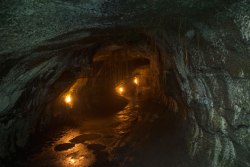
The concept of off-world habitation has been getting extra attention recently, especially with the announcement of 100 semi-finalists selected for the MarsOne “mission” (quotes because there’s more than a small amount of doubt that it will ever really take off – pun intended) and world-famous astronauts like Buzz Aldrin unabashedly telling us to “get our asses to Mars.” But even if we did manage to send a set of human derrières to the Red Planet, where would they call home? Building a safe habitation for humans for any sort of long term stay would be a time-intensive and expensive challenge, to say the least, and the environment of Mars – regardless of how much it might look like the deserts of Arizona or Utah in pictures – is harsh, unforgiving, and downright inhospitable for people. A lot of protection against the Martian elements would have to be built into modules for living and working, especially the extreme daily (and seasonal, depending on latitude) temperature changes and exposure to both solar and cosmic radiation. Protection equals mass, and mass equals fuel, and fuel equals more mass… and more money. What if there were a way for humans to set up base somewhere that radiation exposure and temperature variations could be mitigated? Somewhere like an easily-accessible cave where Mars itself could provide safe shelter to astronauts?
(Hey, it worked well for humans in the past.)
Of course, Mars doesn’t (as far as we know) have caves carved out of limestone like many of those found on Earth. Limestone is mostly formed by the remains of marine organisms, laid down over millennia as sedimentary layers, in which caverns get excavated through mechanical and chemical erosion by water. But Mars does (again, as far as we know) very likely have caves carved by lava – or, more accurately, empty underground spaces left over from ancient lava flows, like volcanic subway tunnels.

We know this because occasionally the roofs of these tunnels (aka lava tubes) collapse, revealing the empty space below to satellites in orbit like ESA’s Mars Express and NASA’s Mars Odyssey and Mars Reconnaissance Orbiter. Lava tubes have also been found on the Moon and here on Earth, where they have been explored and in many cases found to harbor their own unique ecological niches.
Unlike limestone caves, lava tubes are made from the same basaltic flows that originated from the volcanic eruption that created them as well as the surrounding surface. Investigating a lava tube provides a view of the composition of the flow itself from within, unexposed to external influences – a planetary geologist’s dream.
If human explorers on Mars could gain access to a lava tube, they could not only study it scientifically but also potentially set up camp inside it, shielding themselves and their equipment from the damaging radiation levels present on the surface (Mars lacks a protective atmosphere and magnetic field like Earth’s) and only have to deal with one external temperature: whatever is found inside the tube.
Based on measurements from the MSL mission, the exposure to radiation during a 500-day stay on the surface of Mars would be equivalent to about six times the annual cosmic radiation experienced on Earth, or 1/3 more than the annual allowed limit of a U.S. Department of Energy employee. (This does not take into consideration the voyage to and from Mars.) Source
In addition, the fine sand and dust that covers much of Mars would likely be absent deeper inside a lava tube, reducing the challenges of keeping equipment clean and avoiding electrostatic discharges.
Plus if there is any liquid water to be found at all on Mars, it’s going to be found underground. A lava tube would provide quicker access to any potential water sources.

But tubes on Mars pose their own risks. Access would have to be relatively easy for suited astronauts and their vehicles to negotiate (yet still be protective enough to make the effort worthwhile) and the tubes would have to be confidently stable… nobody would want to see a team and all their equipment lost or cut off by a cave-in!
And we would have to take into consideration the potential ecology of the lava tube itself first. So far no living organisms have been found on the surface of Mars, but subsurface life hasn’t yet been ruled out. If lava tubes could provide protection for Earthly life, they could also have offered a safe place for any endemic Martian life to exist and thrive over the eons. We would neither want to risk affecting any potential populations of tube-critters nor deposit our own.

“Tubes and caves represent a prime location to focus the search for life, liquid water, and they would provide numerous opportunities for geological studies that could reveal much about the history of Mars. They could also provide a means of reducing the landed payload mass for manned Mars missions by providing shelter from UV radiation, wind storms, and large temperature fluctuations. However, preinvestigation of the tubes would be necessary to assure that the environment is sterile, and precautions would need to be taken to prevent the transplantation of terrestrial microorganisms.”
– Lunar and Martian Lava Tube Exploration as Part of an Overall Scientific Survey, Andrew Daga, Department of Space Studies, University of North Dakota, Grand Forks, ND
Clearly we wouldn’t want to rush into an off-world spelunking adventure. Preliminary research and robotic exploration would be required to even begin to make a responsible choice as to how we should set up house on Mars, or maybe first on the Moon. But the obvious benefits are there and again, cave-dwelling is nothing unusual for humans. It’s quite possible that our future existence on other worlds will require us to return to a way of life we relied upon tens of thousands of years ago.
Source: Lunar and Planetary Institute submitted white paper, A. Daga et al.
Read more about lava tube exploration in the links below:
Astrobiology Magazine: Living Large in a Lava Tube
Kinohi Institute: Life in Lava Tubes
Space.com: Mars Caves and Lava Tubes
USGS: Candidate Cave Entrances on Mars (by Glen E. Cushing)
Oregon State University: Scientists find microbes in lava tube living in conditions like those on Mars
Bob King: Giant Cave Found on Mars
Discovery News: Robots to go Spelunking in Martian Caves?
Universe Today: This Company Wants to Send Robots Into Lunar Caves
NASA Science News: Down the Lunar Rabbit Hole

Also could the colonists be assured that lava would not once more flow through these tubes?
LikeLike
Pretty much. Mars has been non-volcanically active for at least 10-20 million years.
LikeLike
Very interesting article.
Seen like this lava tubes could be an interesting place for future astronauts and above all a good shelter to externals Mars conditions…
Jeff Barani from Vence (France)
LikeLike